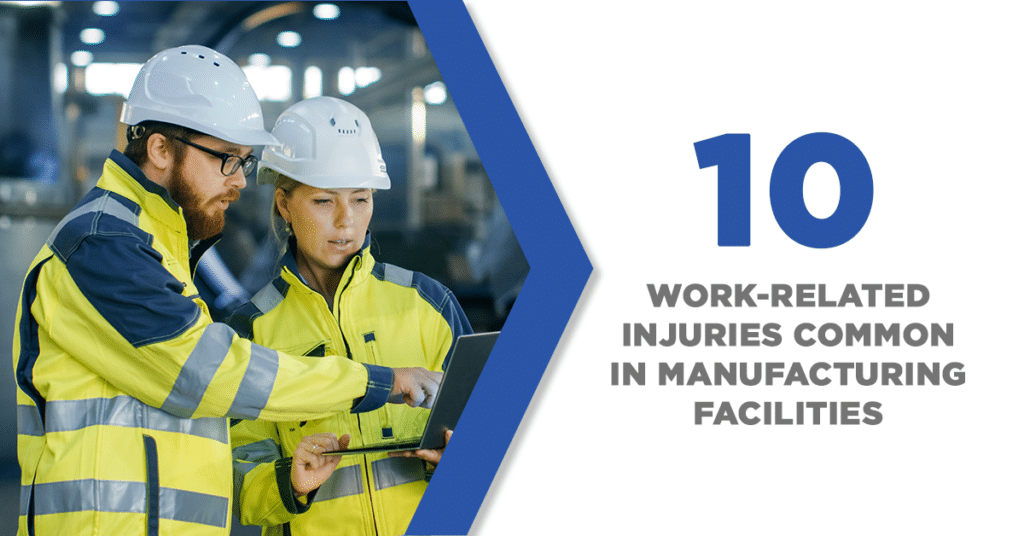10 Work-Related Injuries Common in Manufacturing Facilities

Workplace accidents happen more often than you’d think. According to the International Labor Organization, over 340 million work-related injuries happen every year, and most victims belong to the younger and older demographics of the workforce.
While these facts are far from shocking, they are nonetheless a real cause for concern. This is especially true for those who are working in hard-industries such as manufacturing.
A report from 2019 shows that medically consulted injuries in the manufacturing industry have reached a staggering amount of 555,000. That makes sense given how workers in this sector lift heavy loads, operate machinery, and handle sensitive materials regularly. These job requirements expose them to a horde of dangers that can result in long-term ailments, disabilities, or even death.
That’s why it’s important that you prioritize workplace safety as a business owner or manager. To achieve that objective, the first step is knowing the most common accidents that transpire in the workplace.
1. Musculoskeletal disorders (MSD)
Musculoskeletal disorders are illnesses that are caused by overexertion. Since employees in manufacturing facilities regularly conduct physically demanding tasks, their nerves, muscles, and joints may get damaged over time. During operations, remind your workers to stretch, maintain proper posture, or use the right techniques when performing tasks.
2. Falling objects
Factories usually have multi-tiered storage systems. Sometimes objects fall on their own, with only gravity to blame. Other times a coworker retrieving something from a higher level might accidentally drop something that hits another worker on a lower floor. Wearing hard hats and placing warning signs should keep this issue at bay.
3. Exposure to harmful substances
Your workers’ level of susceptibility to harmful substances depends on the products they handle. For instance, if you’re a garment manufacturer, there’s little risk. Meanwhile, if you produce paints, there are toxic fumes to worry about.
Exposure in small doses may be okay, but long-term exposure may potentially cause illnesses such as cancer. Investing in safety tools such as industrial masks or improving your ventilation system will help you solve this dilemma.
4. Ear damage from loud noise
There’s the so-called industrial deafness which was widespread before in heavy industries. The sad fact is it’s not entirely a thing of the past. Factories operating loud machinery should equip their workers with sufficient ear protection. Designating a quiet room or reminding them to take ear breaks are other good ways to prevent hearing deficiencies.
5. Repetitive stress injuries
The symptoms of repetitive stress injuries include pain, tingling, and numbness. The common triggers include staying in the same position for prolonged periods, using the same muscle group for an entire day’s work, and handling of vibrating equipment repeatedly.
6. Machine-related injuries
It can’t be helped for factory workers to use machinery. If there’s not enough personal protective equipment (PPE), the risks cannot be understated. Make sure your employees wear complete and proper gear at all times and that users have been adequately trained to handle such equipment.
7. Burns
Burns are highly prevalent in facilities that handle flammable substances. However, it’s important to know that the risk of a burn is not limited to these environments alone. As with all hazards in the workplace, taking a proactive approach to fire prevention will help you avoid fire/heat-related incidents.
8. Cuts and lacerations
Cuts and scrapes are closely related to the use of machinery (e.g., forklift) or simple office tools like a pair of scissors. For your workers’ safety, protective gloves and equipment should be available. To grant an extra layer of protection, make sure that you have a first-aid kit ready.
9. Electrocution
Given that electrocution can be fatal, there should be no exposed live wires throughout your workplace. Employees handling electric machinery should be properly trained and must wear the right attire and equipment for the job.
10. Slips and falls
Whether it’s a traditional office space or an industrial facility, wet surfaces can pave the way for a painful accident. Slippage can result in a bandaged foot at best and a cranial injury at worst, so make it a point to clean floors and place signs.
If your employees regularly handle commercial ladders, you should take the same approach as well. Reminding them to wear the right attire and inspecting these tools before use can help them avoid falls from great heights.
Take Safety Personally
As an employer, you should know that you are accountable for the well-being of your staff. Failure to provide a safe working environment won’t just damage your company’s reputation. It may also lead to the sickness and death of your most valuable assets—your employees.
As you hire new workers, ensure that you’re onboarding and training programs encompass safety protocols and the proper use of company resources.
To keep untoward incidents at bay, it will be in your best interest to purchase high-quality equipment. If your employees need to regularly access manholes, rooftops, and other hazardous areas, purchasing a fixed aluminum ladder with a fall protection system will be one of your best decisions.
Aluminum is non-corrosive, making it an ideal material for ladders. Pairing it with other ladder accessories such as safety brackets and landing platforms will ensure that your employees stay safe at work. So if you want to give your staff protection against sudden slippages and falls, take some time to look into our product catalog. If you have any looming concerns, get in touch with us to learn more!